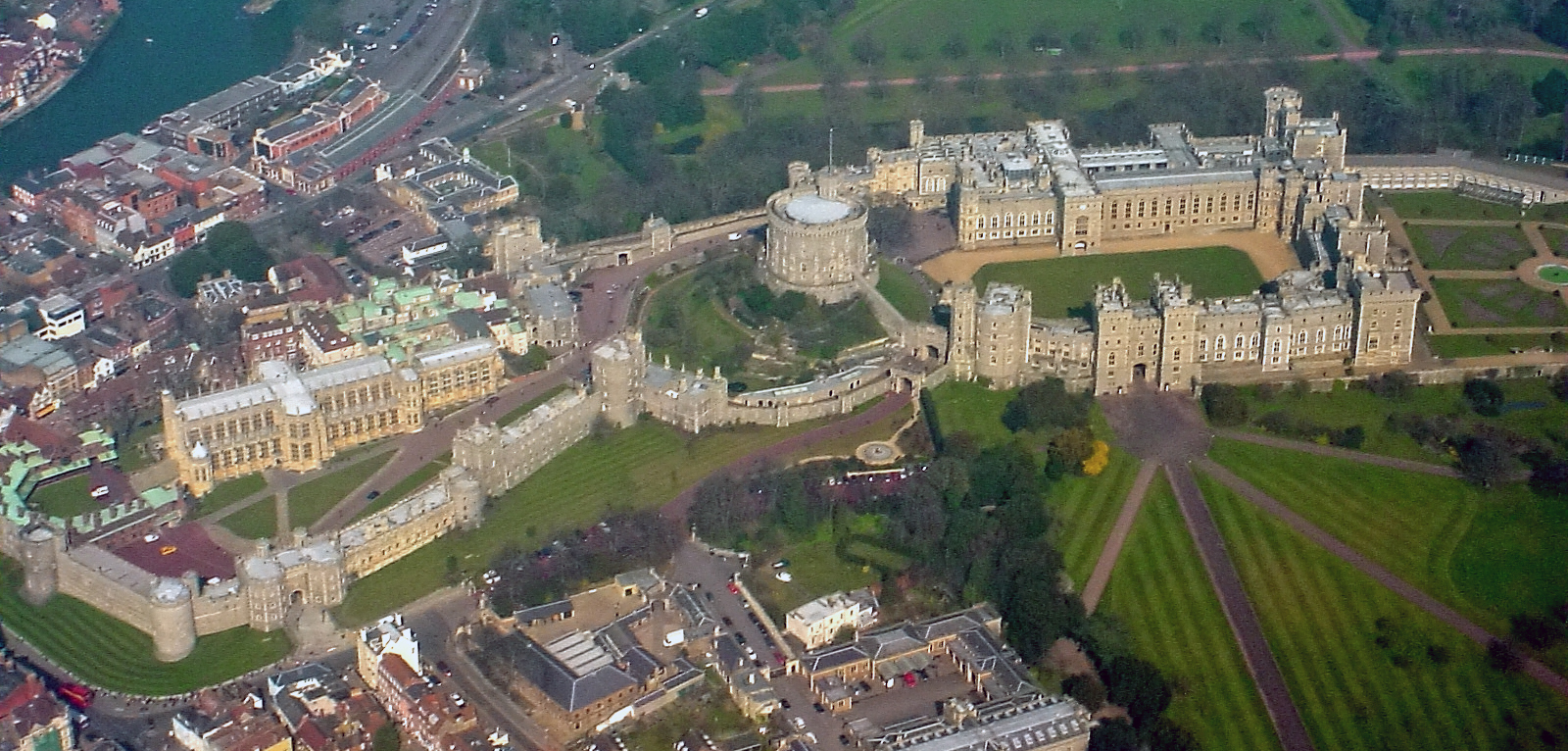by Susan Flantzer © Unofficial Royalty 2013

Aerial view of Windsor Castle, Photo Credit – Wikipedia
On November 24, 1992, in a speech at the Guildhall in London marking the 40th anniversary of her accession, Queen Elizabeth II said “1992 is not a year on which I shall look back with undiluted pleasure. In the words of one of my more sympathetic correspondents, it has turned out to be an ‘Annus Horribilis‘.” Indeed it was a horrible year for the Queen. In March 1992, it was announced that the Duke and Duchess of York would separate. In April, the Princess Royal divorced her husband, Captain Mark Phillips. In June, the Princess of Wales’ tell-all book, Diana, Her True Story by Andrew Morton, was published. Just two weeks after the Guildhall speech, on December 9, Prime Minister John Major announced to Parliament that the Prince and Princess of Wales would separate, something the Queen must have known about at the time of her speech. And on November 20, just four days before the Guildhall speech, a fire seriously damaged Windsor Castle, the Queen’s oldest home with the most history.
Windsor Castle, an official residence of the British monarch, has been a royal residence for over 900 years and has the distinction of being the world’s longest-occupied castle and the world’s largest occupied castle. William the Conqueror chose the site, high above the River Thames, because it was a day’s march from London and therefore could guard the western approaches to London. The outer walls of today’s castle are in the same place as those of the original castle, as is the central mound supporting the Round Tower and the Upper Ward, where monarchs have had their private apartments since the fourteenth century. Originally built out of wood, much of Windsor Castle was rebuilt in stone in the 1170s by Henry II. In the 1360s, Edward III built St. George’s Hall for the use of the knights of his newly founded Order of the Garter. St. George’s Chapel, dedicated to the patron saint of the Order of the Garter, was begun by Edward IV in 1475 and completed by Henry VIII. Eleven British monarchs and other members of the British Royal Family are buried in St. George’s Chapel.

Plan of Windsor Castle, Photo Credit – Wikipedia
Key to Plan
A: The Round Tower
B: The Upper Ward, The Quadrangle
C: The State Apartments
D: Private Apartments, overlooking the East Terrace
E: South Wing, overlooking The Long Walk
F: Lower Ward
G: St. George’s Chapel
H: Horseshoe Cloister
L: The Long Walk
K: King Henry VIII Gate (principal entrance)
M: Norman Gate
N: North Terrace
O: Edward IV Tower
T: The Curfew Tower
On November 20, 1992, at 11:33 AM, a fire began in the Private Chapel when a spotlight left too close to curtains by a painter, started the fire. The location of the fire was shown on a map of the castle by an indicator light and the chief officer of the castle’s fire brigade immediately sounded the public fire alarm. The fire was initially in the Brunswick Tower, but soon many other indicator bulbs lit up, as the fire spread to neighboring rooms, including the State Apartments which are the rooms the public is allowed to visit. Prince Andrew was the only member of the Royal Family at the castle and advised the Queen of the fire via mobile phone and then helped in the removal of valuable items. By 12:20 PM, the fire had spread to St. George’s Hall, built in the 1360s and the largest of the State Apartments, and the roof of St. George’s Hall would later collapse. The Queen arrived at 3 PM and stayed at the castle for an hour, returning again the following morning. Prince Charles visited in the evening and Prince Andrew briefed the press at 3 PM.

Queen Elizabeth II looks shocked as she views the fire damage, Credit – www.huffingtonpost.co.uk
It took 15 hours and one-and-a-half million gallons of water to put out the fire. Nine principal rooms and over 100 other rooms over an area of 9,000 square meters were damaged or destroyed by the fire, approximately 20% of the area of the castle. There were no deaths or serious injuries, but Christopher Lloyd, the Surveyor of The Queen’s Pictures, suffered a suspected heart attack, five firefighters were taken to the hospital with minor injuries, and a decorator in the Private Chapel suffered minor burns while rescuing paintings. Firefighters, castle staff, and some local people were able to save many valuable items including furniture and works of art from the endangered apartments, including a 150-foot long table, a 120-foot long carpet from the Waterloo Chamber, 300 clocks, a collection of miniatures, many thousands of valuable books and manuscripts, and old Master drawings from the Royal Library.
The restoration of the damaged areas took five years and was completed six months ahead of schedule on 20 November 1997 at a cost of £37 million (US $59.2 million), £3 million below budget. 70% of the cost of restoration was to be met by charging the public entry fees to the Windsor Castle precincts, and to Buckingham Palace. Queen Elizabeth II contributed £2 million.
This article is the intellectual property of Unofficial Royalty and is NOT TO BE COPIED, EDITED, OR POSTED IN ANY FORM ON ANOTHER WEBSITE under any circumstances. It is permissible to use a link that directs to Unofficial Royalty.

